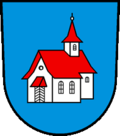Kappel SG
| SG is the abbreviation for the canton of St. Gallen in Switzerland and is used to avoid confusion with other entries of the name Kappel . |
| Chapel | ||
|---|---|---|
| State : |
|
|
| Canton : |
|
|
| Constituency : | Toggenburg | |
| Political community : | Ebnat-Kappel | |
| Postal code : | 9642 | |
| former BFS no. : | 3353 | |
| Coordinates : | 727 089 / 236526 | |
| Height : | 630 m above sea level M. | |
|
Parish before the merger in 1965 |
||
| map | ||
|
|
||
Kappel was a municipality in the Obertoggenburg district , in the canton of St. Gallen , in Switzerland . On January 1, 1965, Kappel merged with the former municipality of Ebnat to form the municipality of Ebnat-Kappel . Today Kappel is part of the village of Ebnat-Kappel.
geography
Kappel is located in Toggenburg in the Thur Valley between Nesslau and Wattwil . The village was completely separated from the associated land by the municipality of Ebnat. In addition to the street village of Kappel, there is a distinct single farm settlement in the pre-Alpine hilly landscape. The municipal area reached from the Speer to 1950 m above sea level. M. in the south to the Bendel north of the Thur.
history
The first mention of the field name was in 912 as Hohenwarta . Mixed manorial rights resulted in the separation of the village and the rest of the municipality. The monastery of St. Johann came into possession of the chapel's patronage rights in 1218 . As a result, Kappel belonged to the St. Johanner court Thurtal, Ebnat to the court Iberg . In 1468, like the rest of Toggenburg, Kappel was bought by the prince abbey of St. Gallen and became a parish in 1477 . After the Reformation the church was used for evangelical worship, after 1593 on equal terms . A Catholic parish was established in 1620 and a Protestant parish in 1679. The patrician house zum Felsenstein, built by Hans Heinrich Bösch in 1624, documents the prosperity and leadership role of individual families. In 1803 Kappel became a political municipality in the new canton of St. Gallen.
In the pre-industrial economy, cattle breeding with alpine farming dominated. In the textile processing, first the cotton developed in the 18th century spinning , and later the cotton weaving cottage industries. From the middle of the 19th century there was a red dye works in the village, the embroidery industry gained in importance after 1860; In 1865 the mechanical colored weaving mill in Trempel was expanded. Kappel took off as a whey and climatic health resort. The village fire in 1854 destroyed 71 houses and both churches. In the heyday of embroidery, the railway line from Wil to Ebnat-Kappel was opened in 1870 and extended to Nesslau in 1912 . After the First World War, a wide range of small industries secured the population despite the embroidery crisis. Industrialization promoted the growing together with Ebnat: In 1841 the secondary school Ebnat-Kappel was established, in 1943 the private village community Ebnat-Kappel and in 1965 the municipality merged.
| year | 1827 | 1860 | 1900 | 1950 | 1960 |
| Residents | 1995 | 2229 | 2187 | 1883 | 1968 |
Individual evidence
-
↑ a b c d Hans Büchler : Kappel (Toggenburg). In: Historical Lexicon of Switzerland .
These sections are largely based on the entry in the Historical Lexicon of Switzerland (HLS), which, according to the HLS's usage information, is under the Creative Commons license - Attribution - Distribution under the same conditions 4.0 International (CC BY-SA 4.0).






